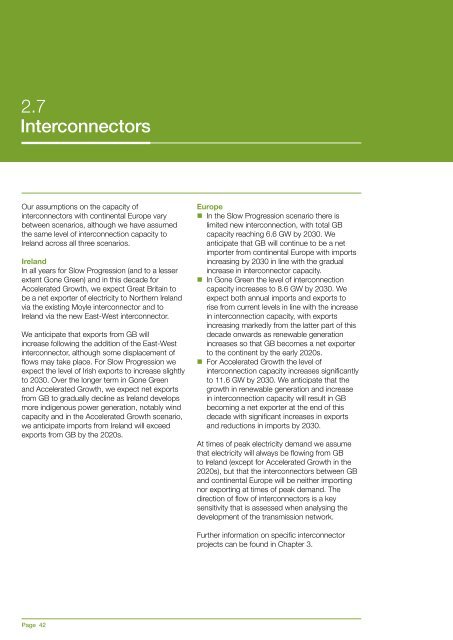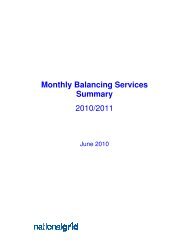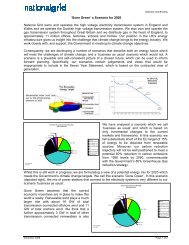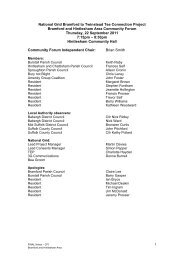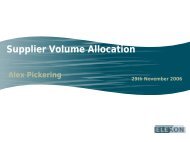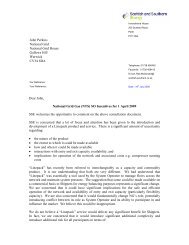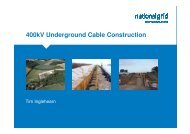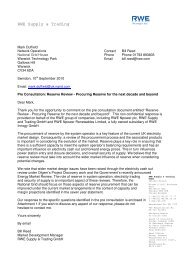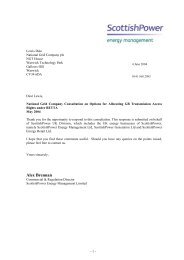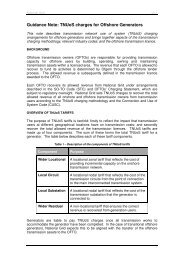Electricity Ten Year Statement - National Grid
Electricity Ten Year Statement - National Grid
Electricity Ten Year Statement - National Grid
You also want an ePaper? Increase the reach of your titles
YUMPU automatically turns print PDFs into web optimized ePapers that Google loves.
2.7<br />
Interconnectors<br />
Our assumptions on the capacity of<br />
interconnectors with continental Europe vary<br />
between scenarios, although we have assumed<br />
the same level of interconnection capacity to<br />
Ireland across all three scenarios.<br />
Ireland<br />
In all years for Slow Progression (and to a lesser<br />
extent Gone Green) and in this decade for<br />
Accelerated Growth, we expect Great Britain to<br />
be a net exporter of electricity to Northern Ireland<br />
via the existing Moyle interconnector and to<br />
Ireland via the new East-West interconnector.<br />
We anticipate that exports from GB will<br />
increase following the addition of the East-West<br />
interconnector, although some displacement of<br />
flows may take place. For Slow Progression we<br />
expect the level of Irish exports to increase slightly<br />
to 2030. Over the longer term in Gone Green<br />
and Accelerated Growth, we expect net exports<br />
from GB to gradually decline as Ireland develops<br />
more indigenous power generation, notably wind<br />
capacity and in the Accelerated Growth scenario,<br />
we anticipate imports from Ireland will exceed<br />
exports from GB by the 2020s.<br />
Page 42<br />
Europe<br />
In the Slow Progression scenario there is<br />
limited new interconnection, with total GB<br />
capacity reaching 6.6 GW by 2030. We<br />
anticipate that GB will continue to be a net<br />
importer from continental Europe with imports<br />
increasing by 2030 in line with the gradual<br />
increase in interconnector capacity.<br />
In Gone Green the level of interconnection<br />
capacity increases to 8.6 GW by 2030. We<br />
expect both annual imports and exports to<br />
rise from current levels in line with the increase<br />
in interconnection capacity, with exports<br />
increasing markedly from the latter part of this<br />
decade onwards as renewable generation<br />
increases so that GB becomes a net exporter<br />
to the continent by the early 2020s.<br />
For Accelerated Growth the level of<br />
interconnection capacity increases significantly<br />
to 11.6 GW by 2030. We anticipate that the<br />
growth in renewable generation and increase<br />
in interconnection capacity will result in GB<br />
becoming a net exporter at the end of this<br />
decade with significant increases in exports<br />
and reductions in imports by 2030.<br />
At times of peak electricity demand we assume<br />
that electricity will always be flowing from GB<br />
to Ireland (except for Accelerated Growth in the<br />
2020s), but that the interconnectors between GB<br />
and continental Europe will be neither importing<br />
nor exporting at times of peak demand. The<br />
direction of flow of interconnectors is a key<br />
sensitivity that is assessed when analysing the<br />
development of the transmission network.<br />
Further information on specific interconnector<br />
projects can be found in Chapter 3.


